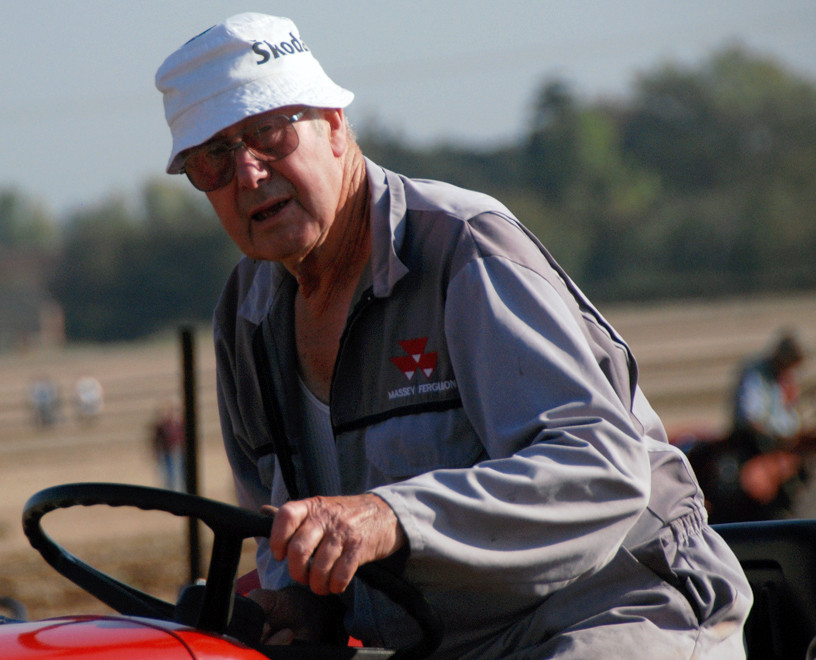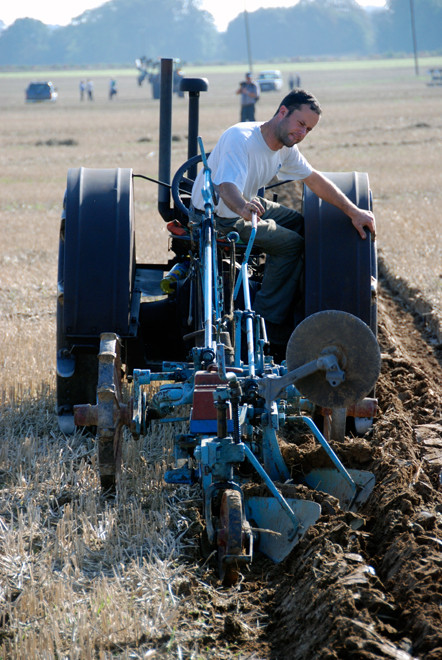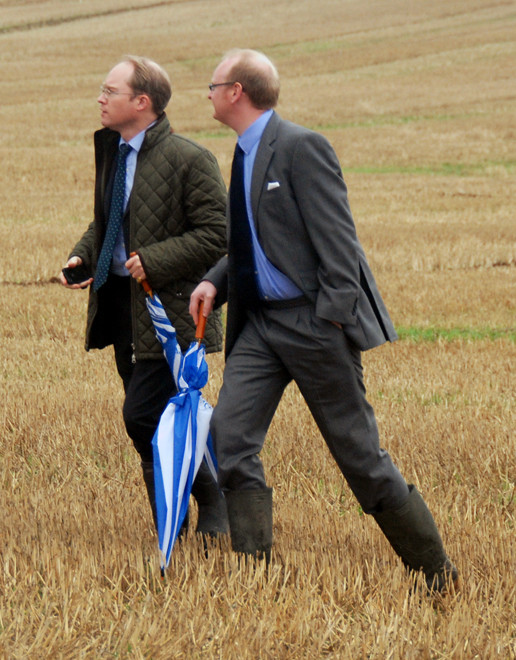God speed the plough: from the ard to the single pass cultivator.

After digging sticks and wooden spades came bronze and iron tools for cultivating the soil. The first wooden plough - the ard or scratch plough - dates from the 6th Millenium B.C. in the Near East. By c.2300 B.C. iron ploughs were being used in both Assyria and Egypt. The ard was not used for clearing land - this was usually done by hand once it had been broken up either with plough or mattocks and hoes. The ard was used for both making seed drills and covering seed once planted and was pulled by oxen, water buffalo, donkeys, camels, or other animals.
The modern plough cuts and inverts the soil, burying weeds and grasses at the bottom of the furrow. After ploughing the land needs to be worked down and compacted into a fine tilth with other tools and machinery: chain and disc harrows, cultivators and rollers before it can be drilled with seed.
With horses ploughing is a co-operative effort that requires cajoling and persuasion. The ploughman talks his two shire horses around their turns at the end of each furrow – ‘ Forward Molly, come on Barney, step up, easy now, steady’ and he leans on the handles of the single-bladed plough to bring it round, then skithers it towards the last-turned furrow, the lead horse stepping into it, and sinks the plough into the soil and the horses pull hard and get up speed.

It’s hard, tough, dirty work; the ploughman directing the plough by main force, walking in the furrow, controlling his two-horsepower ‘motive power unit’ (aka Molly and Barney). With horse the farmer is near the ground, walking the soil, exposed to the elements, literally in the furrow. And then they need feeding, rubbing down, mucking out and part of the farm land devoted to growing crops for their fuel - beans, oats, hay, straw.
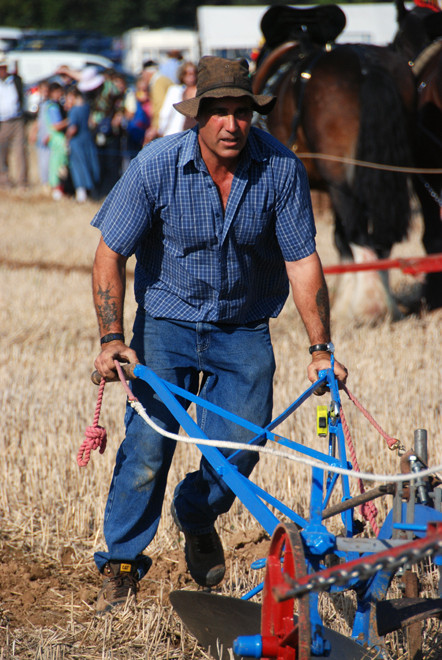
The latest innovation in the ploughing line is to not plough at all. Instead a three piece, all-in-one, single pass cultivator has been developed. This only works the top layer of the soil and avoids the need for multiple passes over the land with plough and cultivator, harrow and soil compactor/roller.
Ploughing, like many aspects of modern agriculture, is a much contested business. Deep ploughing is criticised for disturbing and burying the delicate top layer of soil where the intense life of billions of nematodes makes possible the break-down and uptake of plant nutrients. The increasing weight of machinery can crush the air and life out of the soil. On the other hand, the shift away from the plough to the single-pass machine may be allowing pernicious weeds to make a comeback.
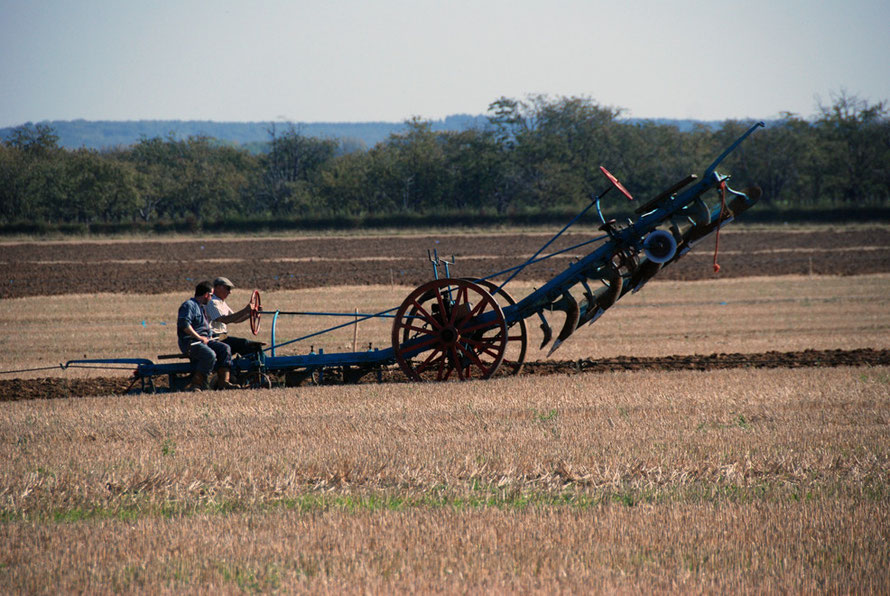
Funnily enough, despite farming accounting for a small percentage of GDP (0.7% UK 2011) and employment (1.7% workforce UK 2009) in the global North, it remains the the main source of income for the majority of the world's poor. And they are threatened by the,
depletion and degradation of land and water pose serious challenges to producing enough food and other agricultural products to sustain livelihoods here and meet the needs of urban populations.
Then there are the economics of ploughing. In today's highly capitalised agriculture getting the most out of expensive kit and labour whilst minimising costs in terms of fuel, wear and tear, maintenance and labour time and maximising the efficiency of inputs like fertilisers, spray and seed is a critical aspect of the land manager. The likes of satellite soil surveys and GPS positioning allow the rate of fertiliser and seed application to be varied with the changing micro-conditions of the soil in the same field.
At the end of the day, the survival of the world's growing population is completely dependent on the continued health of the top few inches of that part of the world's land surface that is
cultivable. Organic farmers argue that intensive and limited rotations of cereals and oilseed rape fed with petrochemically sourced nitrogen fertilisers are leading to the long-term depletion of
the soil as it is compacted, leached, and reduced in humus content and the life is generally cultivated out of it (see Organic Farming and top-soil depletion).
The greater threat may now come from climate change and the increase in average rainfall in the UK and the increasing intensity of rainfall when it comes, interspersed with unusually dry periods (see my page Are you anxious too? for details).
The plough as the first step of mechanised cultivation remains at the centre of these dilemmas and the ability of the ploughman and woman and the land manager to complete successful cycles of seeding and harvest is crucial for all our survival.
The contestant below commented on the weather saying he preferred it hot to rainy and cold, and the last two matches he had been to were that, rainy and cold, local Kent matches at Stone Street and Faversham. He liked to do about 10 matches a year but he’d not done this year due to an operation and a long period of needing to avoid heavy work.
He tamped down an unruly bit of stubble in his next furrow, hitched up his boiler suit and climbed back on his tractor. He pulled away at a sedate snail’s pace.
There is a lot of stopping to adjust ploughs, consult with friends at the end of each furrow. Then they are off. Looked at from the side it looks like a slow motion race – each tractor canted over into its furrow, each ploughman intent on the exact placing of the coulter wheel. The tractors look tiny – like toys- particularly given the size of some of the contestants. In fact, they remind me of those little sunken doors in medieval houses. You think, as you lower your head, ‘ They were so bloody small.’
In the nearest section of the vast spreading field–plain are the vintage tractors, iron-wheeled things and the more familiar Fordsons, Fergies and John Deere’s of plastic farmyard sets and Ladybird books.
The size and youth of the tractors increases as you walk away from the main show area – from the one-ploughshare horse-drawn plough, through the two ploughshare boys (and one girl) of the vintage set to the massive mastodons of the present day with their reversible six ploughshare ploughs and the latest alternative to the plough itself- the cultivator-cum-harrow – a ‘single pass cultivator’, I later learn- made up of sets of angled serrated harrow disks and a close set of tyres to flatten the whole job down.
The soil here on the Lees Court Estate – which is much reduced from its 1940s holding of 85,000 acres to a mere 4,500 acres - is beautiful, moist, sandy, burnt- ochre loam with a few tiny flints – soft, warm, yielding and with almost no smell.
The field itself is stubble and bare, slightly greened earth with a few calendula and forget-me-nots turbo-boosted by residual nitrates. But in all that turned soil I saw only two worms – and them right next to each other. And where the soil was turned it was covered in strands of silky spider’s web catching in the sun.
(For information on the work of Lees Court and the mould-breaking go-ahead 21st-century Countess Sondes see the Lees Court website.)
Watching one of the new fangled non-ploughs I turn to the bloke standing next to me – angular, thin, a relaxed face and Kentish accent - and ask him what it is. He says it's an alternative to a plough, although the machinery goes in cycles and the plough is coming back to deal with persistent weeds like black grass.
The cultivator-cum-harrows are popular because they are fast. A single-pass cultivator is made up of three elements – a sub-soiler, a cultivator, and a soil packer. As he says its all very well ploughing and making nice, neat and pretty but your modern farmer wants his crops in and out and the field reseeded. He doesn’t much care how it's done so long as the costs are contained. Ploughs burn steel and agricultural red diesel, particularly when pulled by a giant tractor working hard.
He goes on to tell me that the old red diesel was full of rubbish and the new electric injection engines can’t deal with its high sulphur content. So the fuel has been further refined but now they are finding that the diesel has a limited shelf-life and 'goes off' if left in a fuel or storage tank for more than a year.
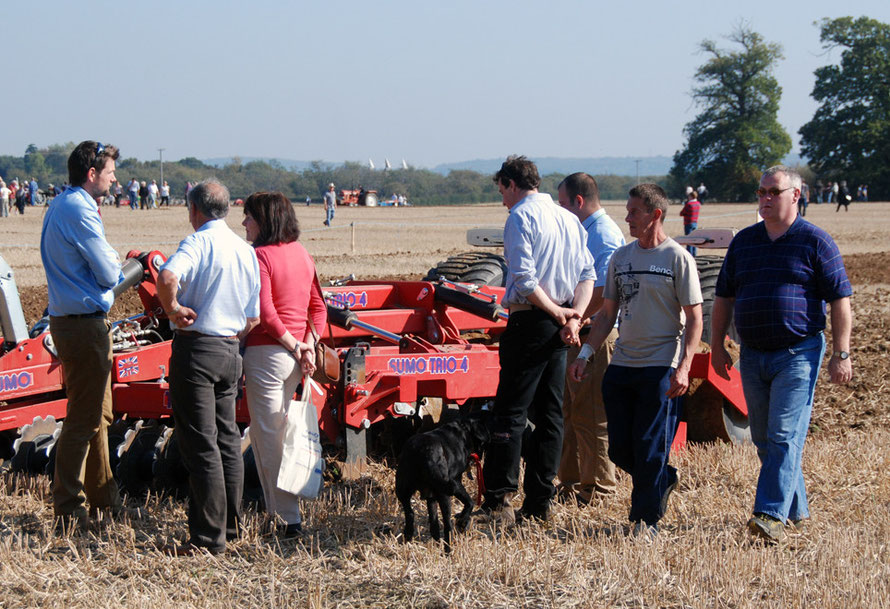
We watch the great machine roaring over the same patch of harried ground, the salesman sealed away in his climate controlled cab with satnav and dark glasses.
The huge, tracked CAT and John Deere tractors and a single-pass cultivator leave little change from a quarter of a million quid and if they go wrong, 'you need the backing of the Bank of England to contemplate fixing them'.

I talk to another ex-contactor standing in front of the viscious, serrated, grasping, cutting and crushing bar of a maize silage harvester. He says that today's diesel goes gummy because of the bio-fuel in it. Either you drain your fuel tanks at the end of the season or the fuel sets in them.
If you empty them as a preventative measure you then get condensation in the tank and can waste a day changing water-infiltrated filters to get the beast working at the start of the season.

He also comments on the modern farmers need to have his crops in and out. He mentions a field of wheat harvested six weeks ago that is now green with its next crop of barley. There is no rest for the land and nor can there be given the huge sums of money spent. He knows a farmer with five tractors and two combines who has a fuel bill of £20,000 a week when all the machines are working hard.
The John Deere 8345RT has a fuel tank capacity of 200 gallons and uses fuel at a rate of 17.28 gallons (65.41 litres) an hour at maximum power (see Tractor Data).
That's 523 litres in an 8 hour day at max power with a cost of £350 when red diesel is 67p a litre. That’s £1,752 for a five day week.
The minimum wage of a Grade 4 craft agricultural workers as established by the Agricultural Wages Order (England and Wales) 2011 is £7.99 an hour or £319 for a forty-hour week. So the tractor costs more than five-times-per-week (just for fuel) than a skilled agricultural worker.
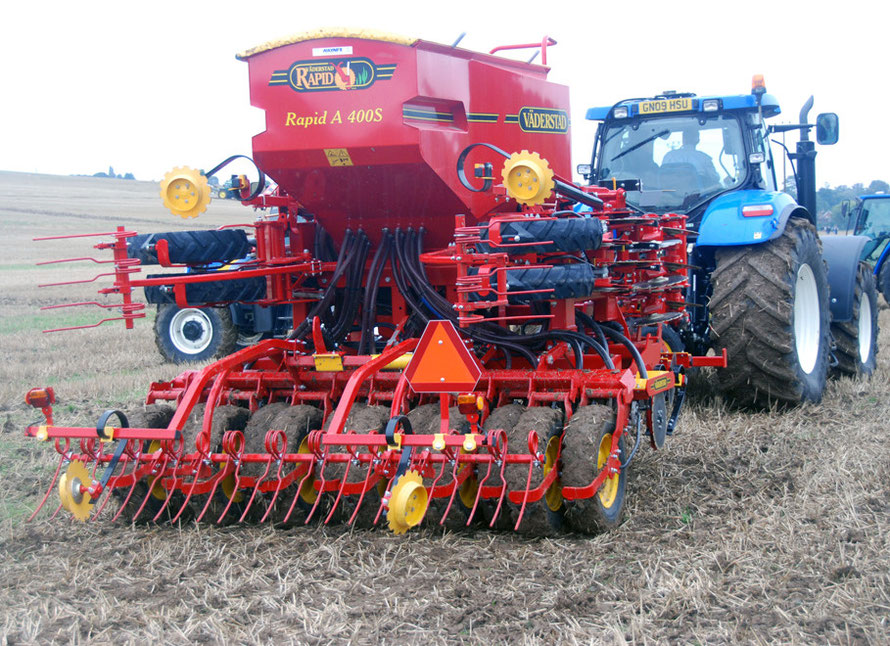
I talk to another guy with a battered John Deere baseball cap and big fuzzy white beard. We reminisce about farming in Wales when horses and small tractors were still used, awed by the sheer scale of the kit around us.
We stand in front of a huge seed drill, that looks like a combination of a fire engine and an operating theatre attached to an equally huge tractor and think, ‘This ain’t right’ but almost as the silent words are silently formed a barrage of argument, unstoppable, stops the thought-utterance.
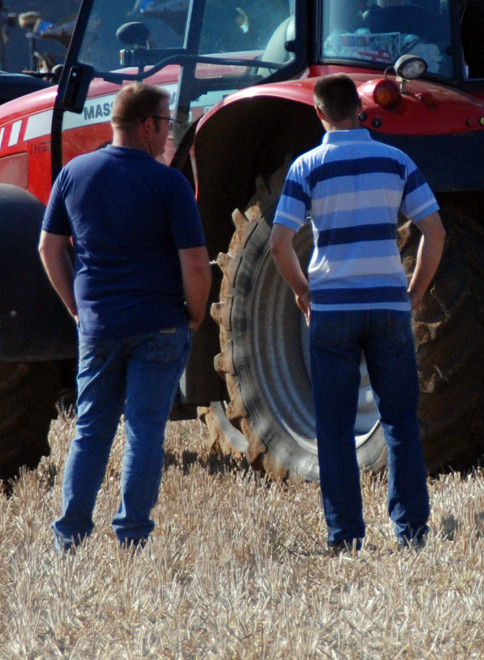
Because this is progress; because this is the way cheap food is produced; because you’d be sorry if the supermarkets ran out of flour; because this is the glory of technology, of human ingenuity; because you wouldn’t want to go back to the horse and plough or that digging-stick the nutty archeologist is hewing in his little demonstration area, would you?
All that anxiety of crop failure, the corn rotting in the winter, ergot and madness, starvation and watching your children die, would you?
‘There is no choice’, says the garish green and the seering yellow. There is no choice says the triple headlights in their sexy, sporty, curvy shapes.
There is no choice says the huge, tracked, 3 metre-high, 15 tonne John Deere 8345RT crawler-tractor bearing down on you at terrifying speed, its massive, infinitely variable, transmission-linked, 387 horse power, 6 cylinder, turbocharged and aftercooled engine snorting with derision.
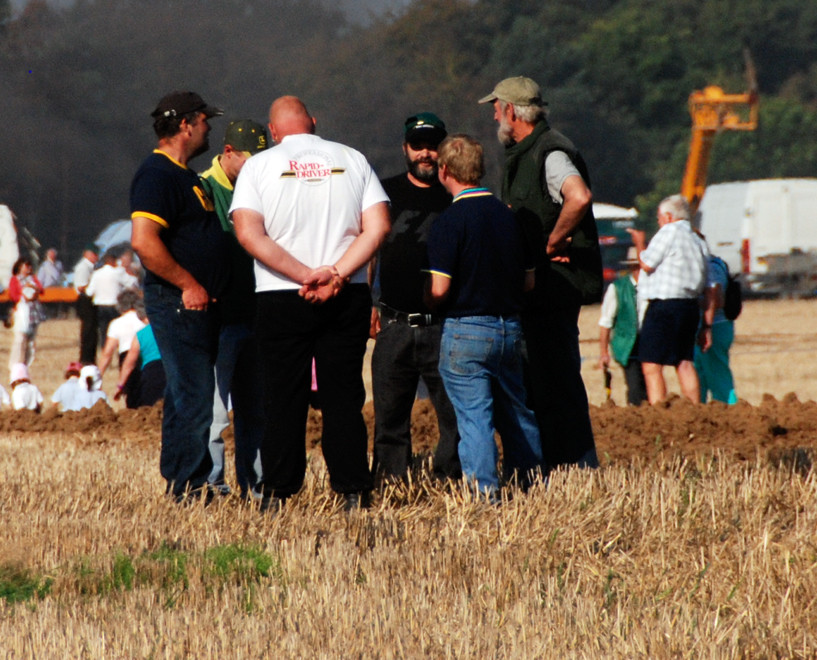
And you sense the orthodoxy, the peer pressure, the rich boys and their wives scarfing down the agri-business burgers and the bottles of spirits discreetly proffered, while the few remaining outsiders, pinch thin and unfashionable, move around the edge of the match, wurzels in an age of GPS and yield optimization, the hold-outs who somehow still hold that most precious commodity, land*.
But who can argue with words like 'high in-field operating speeds' nor be impressed by the sheer scale and crushing magnificence of these bits of techno-wizardry offering such power and prestige to their owners and operators?
* Agricultural Land Values: In October 2011 the property agent, Frank Knight, announced that farmland values had risen by 204% in 10 years in the England, twice the rate of London property prices (102%). International investors are very keen to buy up UK farmland but says KF’s residential researcher, Liam Bailey says, ‘It is hard for them to get the scale they need as a lot of this stuff doesn’t trade but it handed down generation to generation.’
One reason for this is handing down is that farmland and farm buildings usually qualify for agricultural property relief and therefore avoid inheritance tax. (FT 1 October 2011 ‘Farmland value rises 204% in 10 years,’ Ed Hammond).








